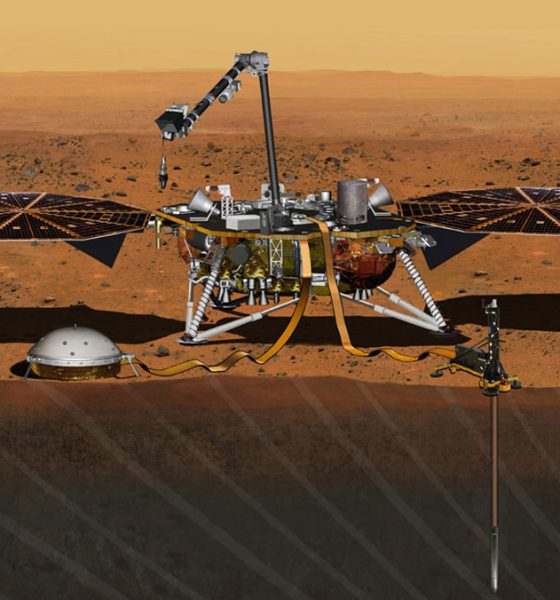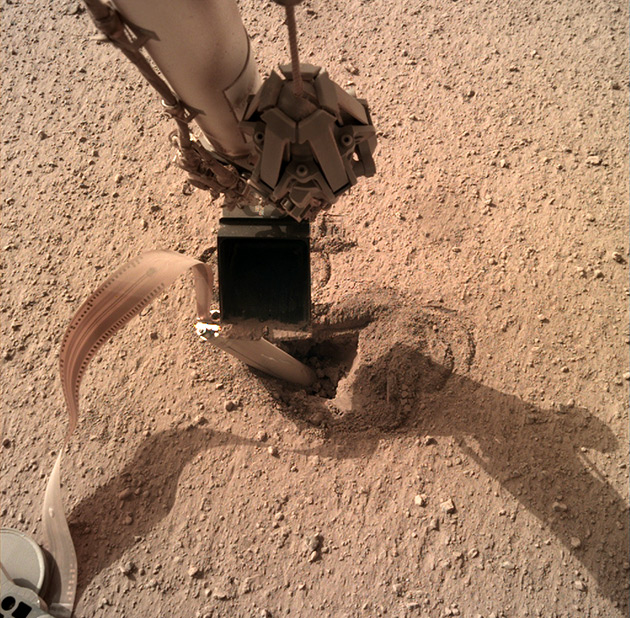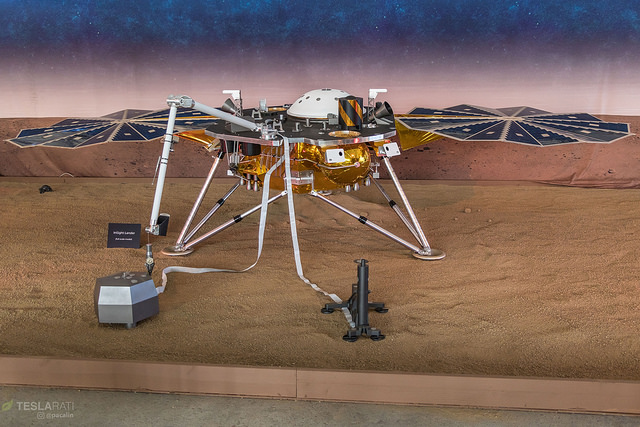

News
NASA’s Insight Mars lander rescue operation makes progress saving ‘stuck’ probe
The scientists running NASA’s Insight Mars lander found themselves attempting a rescue operation for the mission when one of its instruments became stuck in the red planet’s regolith early last year. After a few assistance maneuvers using a robotic shovel-clad arm in the months since, it appears the team has finally reached a point where there’s light at the end of the dusty tunnel.
“Another short test has my self-hammering mole making gradual progress. Pressing down on the soil above has helped it dig a little further. We’ll do another of these moves soon,” the lander’s official Twitter page announced recently.
So what happened?
Another short test has my self-hammering mole making gradual progress. Pressing down on the soil above has helped it dig a little further. We’ll do another of these moves soon, with @NASAJPL and @DLR_en keeping a close eye. #SaveTheMole pic.twitter.com/3s7DVMYJyU
— NASA InSight (@NASAInSight) August 28, 2020
“Our leading theory was that the Mole did not move into the subsurface because the regolith did not provide enough friction to balance the recoil force of the Mole,” explained Tilman Spohn on DLR Blog, a site run by one of NASA’s European Insight partners, the German Aerospace Center.
The stuck instrument, named HP3 (Heat Flow and Physical Properties Package), is one of the three main experiment tools on board the lander. It functions as a 40 cm long self-hammering probe that digs straight down into the surface to measure heat flow from the Martian interior and its thermal state. When operating as designed, the thermal conductivity of the soil is measured every 50 cm up to a depth of 5 meters. NASA’s team refers to the device as a ‘Mole’ as a nod to its underground burrowing, and the hashtag ‘#savethemole’ has become its social media rally cry for supporters of the rescue mission.


Ironically, lack of friction to support planned digging is very similar to a key plot point in the movie The Core. The ship used by the main characters to dig to the center of the Earth was engineered to work in a high pressure environment, but in the film the core wasn’t very solid at all. As is the case with Insight, plenty of scientific thinking was employed to overcome the challenge, albeit a bit less dramatically.
A stuck heat probe isn’t Insight’s only issue of late, either. Weather sensors on board the lander stopped sending data back to Earth a couple of weeks ago, and NASA’s team suspects an electronics issue is to blame. The instruments are currently in safe mode and await a reset while scientists assess what data is available to troubleshoot the issue in the meantime.
Despite its troubles, NASA’s Mars lander has already shared some memorable firsts since its arrival on the red planet two years ago, and it has sent back an enormous amount of data that will be very useful to scientists as humans make their way through space for a meet up one day. For one, Earthlings were able to hear the sound of wind on an alien world for the first time thanks to Insight’s instruments. The lander also proved that hyper-affordable satellites could be used for deep space missions via its travel companions, Mars Cube One. Launch newcomer Rocket Lab is now capitalizing on the prospects of these types of missions, paving the way for big things in the near future.
You can watch an in-depth video about the HP3 instrument below:

News
Elon Musk’s Grok AI to be used in U.S. War Department’s bespoke AI platform
The partnership aims to provide advanced capabilities to 3 million military and civilian personnel.

The U.S. Department of War announced Monday an agreement with Elon Musk’s xAI to embed the company’s frontier artificial intelligence systems, powered by the Grok family of models, into the department’s bespoke AI platform GenAI.mil.
The partnership aims to provide advanced capabilities to 3 million military and civilian personnel, with initial deployment targeted for early 2026 at Impact Level 5 (IL5) for secure handling of Controlled Unclassified Information.
xAI Integration
As noted by the War Department’s press release, GenAI.mil, its bespoke AI platform, will gain xAI for the Government’s suite of tools, which enable real-time global insights from the X platform for “decisive information advantage.” The rollout builds on xAI’s July launch of products for U.S. government customers, including federal, state, local, and national security use cases.
“Targeted for initial deployment in early 2026, this integration will allow all military and civilian personnel to use xAI’s capabilities at Impact Level 5 (IL5), enabling the secure handling of Controlled Unclassified Information (CUI) in daily workflows. Users will also gain access to real‑time global insights from the X platform, providing War Department personnel with a decisive information advantage,” the Department of War wrote in a press release.
Strategic advantages
The deal marks another step in the Department of War’s efforts to use cutting-edge AI in its operations. xAI, for its part, highlighted that its tools can support administrative tasks at the federal, state and local levels, as well as “critical mission use cases” at the front line of military operations.
“The War Department will continue scaling an AI ecosystem built for speed, security, and decision superiority. Newly IL5-certified capabilities will empower every aspect of the Department’s workforce, turning AI into a daily operational asset. This announcement marks another milestone in America’s AI revolution, and the War Department is driving that momentum forward,” the War Department noted.
News
Tesla FSD (Supervised) v14.2.2 starts rolling out
The update focuses on smoother real-world performance, better obstacle awareness, and precise end-of-trip routing, among other improvements.

Tesla has started rolling out Full Self-Driving (Supervised) v14.2.2, bringing further refinements to its most advanced driver-assist system. The new FSD update focuses on smoother real-world performance, better obstacle awareness, and precise end-of-trip routing, among other improvements.
Key FSD v14.2.2 improvements
As noted by Not a Tesla App, FSD v14.2.2 upgrades the vision encoder neural network with higher resolution features, enhancing detection of emergency vehicles, road obstacles, and human gestures. New Arrival Options let users select preferred drop-off styles, such as Parking Lot, Street, Driveway, Parking Garage, or Curbside, with the navigation pin automatically adjusting to the user’s ideal spot for precision.
Other additions include pulling over for emergency vehicles, real-time vision-based detours for blocked roads, improved gate and debris handling, and extreme Speed Profiles for customized driving styles. Reliability gains cover fault recovery, residue alerts on the windshield, and automatic narrow-field camera washing for new 2026 Model Y units.
FSD v14.2.2 also boosts unprotected turns, lane changes, cut-ins, and school bus scenarios, among other things. Tesla also noted that users’ FSD statistics will be saved under Controls > Autopilot, which should help drivers easily view how much they are using FSD in their daily drives.
Key FSD v14.2.2 release notes
Full Self-Driving (Supervised) v14.2.2 includes:
- Upgraded the neural network vision encoder, leveraging higher resolution features to further improve scenarios like handling emergency vehicles, obstacles on the road, and human gestures.
- Added Arrival Options for you to select where FSD should park: in a Parking Lot, on the Street, in a Driveway, in a Parking Garage, or at the Curbside.
- Added handling to pull over or yield for emergency vehicles (e.g. police cars, fire trucks, ambulances).
- Added navigation and routing into the vision-based neural network for real-time handling of blocked roads and detours.
- Added additional Speed Profile to further customize driving style preference.
- Improved handling for static and dynamic gates.
- Improved offsetting for road debris (e.g. tires, tree branches, boxes).
- Improve handling of several scenarios, including unprotected turns, lane changes, vehicle cut-ins, and school buses.
- Improved FSD’s ability to manage system faults and recover smoothly from degraded operation for enhanced reliability.
- Added alerting for residue build-up on interior windshield that may impact front camera visibility. If affected, visit Service for cleaning!
- Added automatic narrow field washing to provide rapid and efficient front camera self-cleaning, and optimize aerodynamics wash at higher vehicle speed.
- Camera visibility can lead to increased attention monitoring sensitivity.
Upcoming Improvements:
- Overall smoothness and sentience.
- Parking spot selection and parking quality.
News
Tesla is not sparing any expense in ensuring the Cybercab is safe
Images shared by the longtime watcher showed 16 Cybercab prototypes parked near Giga Texas’ dedicated crash test facility.

The Tesla Cybercab could very well be the safest taxi on the road when it is released and deployed for public use. This was, at least, hinted at by the intensive safety tests that Tesla seems to be putting the autonomous two-seater through at its Giga Texas crash test facility.
Intensive crash tests
As per recent images from longtime Giga Texas watcher and drone operator Joe Tegtmeyer, Tesla seems to be very busy crash testing Cybercab units. Images shared by the longtime watcher showed 16 Cybercab prototypes parked near Giga Texas’ dedicated crash test facility just before the holidays.
Tegtmeyer’s aerial photos showed the prototypes clustered outside the factory’s testing building. Some uncovered Cybercabs showed notable damage and one even had its airbags engaged. With Cybercab production expected to start in about 130 days, it appears that Tesla is very busy ensuring that its autonomous two-seater ends up becoming the safest taxi on public roads.
Prioritizing safety
With no human driver controls, the Cybercab demands exceptional active and passive safety systems to protect occupants in any scenario. Considering Tesla’s reputation, it is then understandable that the company seems to be sparing no expense in ensuring that the Cybercab is as safe as possible.
Tesla’s focus on safety was recently highlighted when the Cybertruck achieved a Top Safety Pick+ rating from the Insurance Institute for Highway Safety (IIHS). This was a notable victory for the Cybertruck as critics have long claimed that the vehicle will be one of, if not the, most unsafe truck on the road due to its appearance. The vehicle’s Top Safety Pick+ rating, if any, simply proved that Tesla never neglects to make its cars as safe as possible, and that definitely includes the Cybercab.








